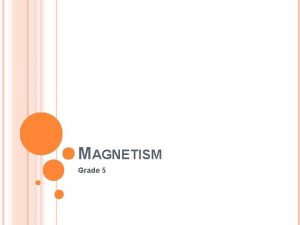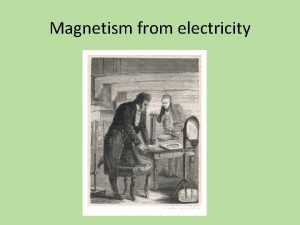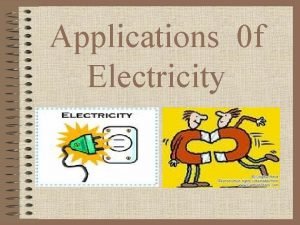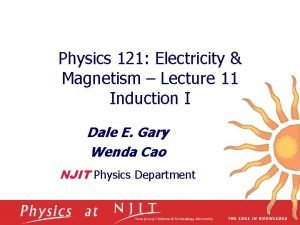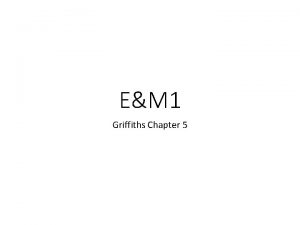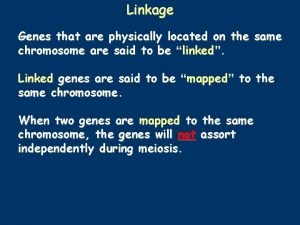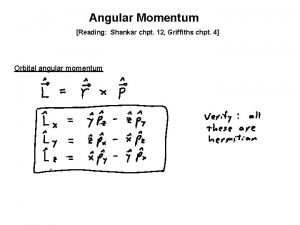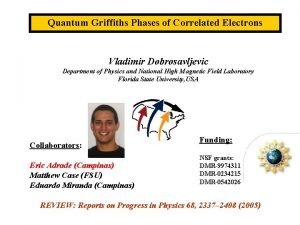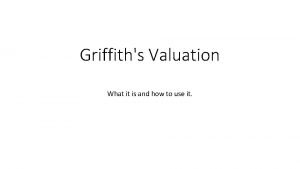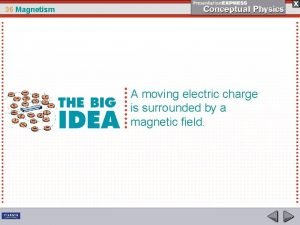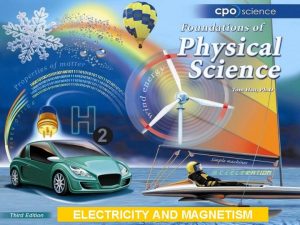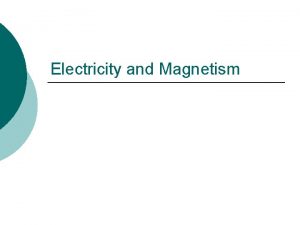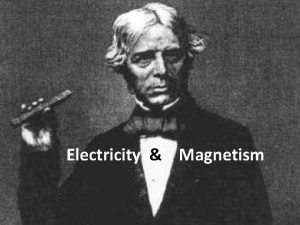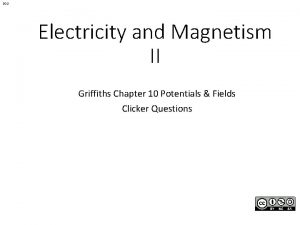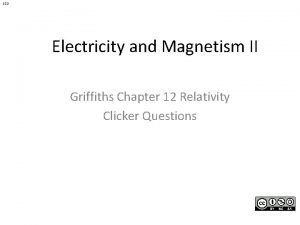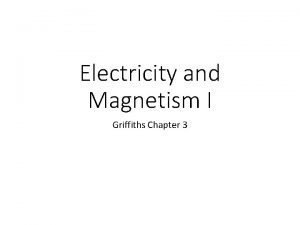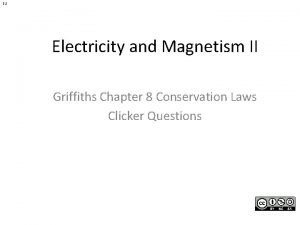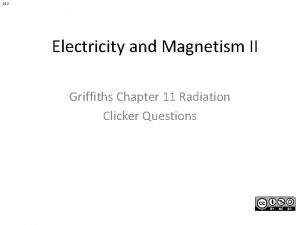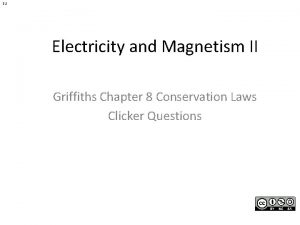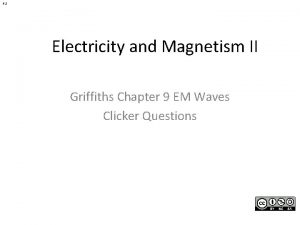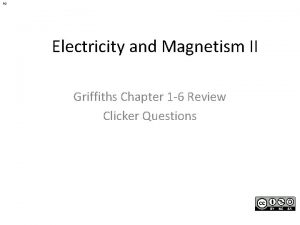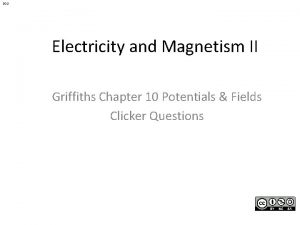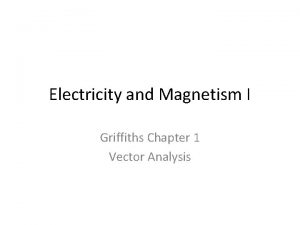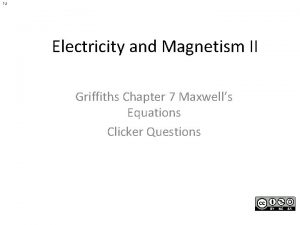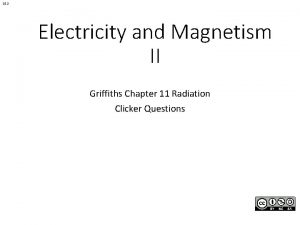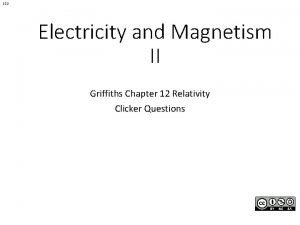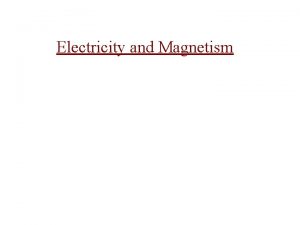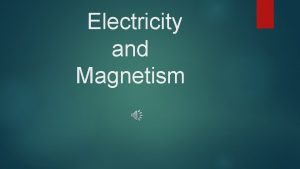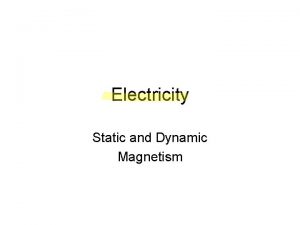9 1 Electricity and Magnetism II Griffiths Chapter































- Slides: 31

9. 1 Electricity and Magnetism II Griffiths Chapter 9 EM Waves Clicker Questions

9. 4 A function, f, satisfies the wave equation: Which of the following functions work? A) Sin( k(x – vt)) B) Exp( k(-x – vt )) C) a( x + vt )3 D) All of these. E) None of these.

9. 6 A “right moving” solution to the wave equation is: f. R(z, t) = A cos(kz – ωt + δ) Which of these do you prefer for a “left moving” soln? A) f. L(z, t) = A cos(kz + ωt + δ) B) f. L(z, t) = A cos(kz + ωt - δ) C) f. L(z, t) = A cos(-kz – ωt + δ) D) f. L(z, t) = A cos(-kz – ωt - δ) E) more than one of these! (Assume k, ω, δ are positive quantities) To think about; Is(are) the answer(s) really just “preference” (i. e. human convention) or are we forced into a choice?

9. 7 Two different functions f 1 (x, t) and f 2 (x, t) are solutions of the wave equation. Is (A f 1 + B f 2 ) also a solution of the wave equation? A) Yes, always B) No, never. C) Yes, sometimes, depending of f 1 and f 2.

9. 8 Two traveling waves 1 and 2 are described by the equations: y 1(x, t) = 2 sin(2 x – t) y 2(x, t) = 4 sin(x – 0. 8 t) All the numbers are in the appropriate SI (mks) units. Which wave has the higher speed? A) 1 B) 2 C) Both have the same speed.

9. 16 The electric field for a plane wave is given by: The vector k tells you: A) The direction of the electric field vector. B) The speed of the traveling wave. C) The direction the plane wave moves. D) A direction perpendicular to the direction the plane wave moves E) None of these/MORE than one of these/? ? ?

9. 22 The electric fields of two E/M waves in vacuum are both described by: The "wave number" k of wave 1 is larger than that of wave 2, k 1 > k 2. Which wave has the larger frequency f? A) Wave 1 B) Wave 2 C) impossible to tell

9. 23 The electric field of an E/M wave is described by k = 0. 1 m-1, at x=1 m and t=0, what is the direction of the B-field? A) +x B) +y C) –x D) +z E) -z

9. 27 An electromagnetic plane wave propagates to the right. Four vertical antennas are labeled 1 -4. 1, 2, and 3 lie in the x-y plane. 1, 2, and 4 have the same x-coordinate, but antenna 4 is located further out in the z-direction. Rank the time-averaged signals received by each antenna. A) 1=2=3>4 D) 1=2=3=4 B) 3>2>1=4 E) 3>1=2=4 C) 1=2=4>3 y 1 2 3 z 4 x

9. 32 For a plane electromagnetic wave in vacuum: • E k E • B k • E B • E, B in phase k B • B = E/c Which of Maxwell’s equations requires that B k ? Which of Maxwell’s equations requires that B = E/c ?

9. 38 A plane wave normally incident on an interface between 2 linear (non-magnetic) dielectrics (n 1 ≠ n 2) EI 1 v 1 BI ER v 1 BR x 2 ET z v 2 BT How do k 1 and k 2 compare? How do w 1 and w 2 compare? A) k 1=k 2, w 1=w 2 B) k 1 ≠ k 2, w 1 ≠ w 2 C) k 1 = k 2, w 1 ≠ w 2 D) k 1 ≠ k 2, w 1 = w 2

9. 40 “Wave on a 1 D string”, hitting a boundary between 2 strings of different speeds: Boundary conditions (continuity) give the results: Is the transmitted wave in phase with the incident wave? A) Yes, always B) No, never C) Depends Why? How do you decide?

9. 41 “Wave on a 1 D string”, hitting a boundary between 2 strings of different speeds: Boundary conditions (continuity) give the results: Is the reflected wave in phase with the incident wave? A) Yes, always B) No, never C) Depends Why? How do you decide?

9. 44 In matter, we have If there are no free charges or currents, can we argue A) B) C) D) Yes, always Yes, under certain conditions (what are they? ) No, in general this will NOT be true! ? ?

9. 45 In matter with no free charges or currents, we have: To figure out formulas for boundary conditions, match the picture to the PDE(s) above. Fig 1 A) Fig 1 goes with i and iii (i. e. the ones involving D and E), Fig 2 goes with ii and iv (“” B and H) B) Fig 1 goes with i and ii (“” div), Fig 2 goes with iii and iv (“” curl) C) Fig 1 goes with ii only Fig 2 goes with iii only D) Something else! (“” B field), (“” E field) E) Frankly, I don’t really understand this question. Fig 2

9. 46 Region 1 Match the Maxwell equation (i-iv) in matter (no free charges) with the corresponding boundary condition (1 -4) it generates: A) i 4, ii 3 iii 2 iv 1 B) i 2, ii 1 iii 4 iv 3 C) Wait, only SOME of the BC’s on the right are correct! D) Wait, NONE of the BC’s on the right are correct! E) Frankly, I don’t really understand this question. Region 2

9. 47 Region 1 Match the Maxwell equation (i-iv) in matter (no free charges) with the corresponding boundary condition (1 -4) it generates: B) i 2, ii 1 iii 4 iv 3 Region 2

9. 58 In the case where medium 1 had a very slow wave velocity and medium 2 had a much higher wave velocity, μ 2 v 2 >> μ 1 v 1. Assuming that the permeabilities (μ’s) are essentially equal to the permeability of the vacuum, what is the relation between ε 1 and ε 2? A. ε 1 ≅ ε 2 B. ε 1 > ε 2 C. ε 1 < ε 2 D. Not enough information to tell

9. 60 For light at normal incidence, we found: What gives a large transmission of light at normal incidence? A) When v 1>>v 2 B) When v 2>>v 1 C) When v is very different in the two media D) When v is nearly the same in the two media E) None of these/other/I’m confused/…

9. 61 For an electric plane wave given by The contribution from the E field to the (real) energy density u. EM is A. B. C. D. E. More than one of the above is true

9. 63 An ideal (large) capacitor has surface charge density +σ on its top plate and –σ on its bottom plate. There is only vacuum between the plates. What is E inside the capacitor ? +σ A) E = σ/ε 0 ẑ B) E = -σ/ε 0 ẑ C) E = σ/2ε 0 ẑ D) E = -σ/2ε 0 ẑ E) None of the above -σ

9. 64 An ideal (large) capacitor has surface charge density +σ on its top plate and –σ on its bottom plate. Now a linear dielectric with permittivity ε is inserted between the plates. How does E inside the dielectric compare with the case with no dielectric? +σ A) E is smaller B) E is the same C) E is larger D) Depends on the ε of the dielectric E) Not enough information to tell -σ

9. 69 1 2 θ 1 The power/m 2 passing Here is <S> What is the power/m 2 striking the boundary wall? A) Still <S> B) <S> cosθ 1 C) <S> /cosθ 1 D) Something else! (sinθ 1 or cos 2θ 1 or cosθ 2, or …)

9. 72 The square root of a + bi is D. It is not defined E. Something else (this is harder than it looks)

9. 80 From last class: If you model a dielectric as “charges on springs” (with damping) a traveling EM wave will drive those charges, resulting in polarized molecules. If x(t)=displacement of charge q, and N = molecules/volume, what is the volume polarization, P?

9. 86 For our atomic model of permittivity we found the absorption coefficient to be: In the limit of large ω, α A. Goes to zero B. Approaches a constant C. Goes to infinity D. I don’t know!

9. 87 For our atomic model of permittivity we found the absorption coefficient to be: In the limit of no damping, absorption A. Goes to zero B. Approaches a constant C. Goes to infinity D. Other, (it’s not so simple). E. I don’t know!

9. 89 What is the electric field in a perfect conductor if an EM wave is incident on the surface? A. Zero B. Depends on the angle of incidence C. Depends on whether the EM wave is in a dielectric or vacuum D. Perfectly in phase with the incident wave but decreasing with distance into the conductor E. Not enough information to say

9. 90 What is the magnetic field in a perfect conductor if an EM wave is incident on the surface? A. Zero B. Depends on the angle of incidence C. Depends on whether the EM wave is in a dielectric or vacuum D. Out of phase with the incident wave and decreasing with distance into the conductor E. Not enough information to say

9. 94 For TEmn modes we found the general dispersion relation with What is the phase velocity of the waves in the waveguide? A. ωmn/k B. ω/k C. c D. E. None of the above

9. 95 For TEmn modes we found the general dispersion relation with How does the wavelength of a TE mode compare to that of a plane wave in vacuum with the same frequency? A. The TE mode wavelength is larger than the plane wave’s. B. The TE mode wavelength is smaller than the plane wave’s. C. The TE mode wavelength is the same as the plane wave’s. D. The answer depends on the actual value of the frequency. E. The answer depends on the actual values of the side lengths.
 Physics 102 electricity and magnetism
Physics 102 electricity and magnetism Ib physics topic 5 question bank
Ib physics topic 5 question bank Electricity and magnetism lecture notes
Electricity and magnetism lecture notes Magnetism jeopardy
Magnetism jeopardy Sph3u electricity and magnetism
Sph3u electricity and magnetism Relationship between electricity and magnetism
Relationship between electricity and magnetism Intensity of magnetisation
Intensity of magnetisation Magnetism grade 5
Magnetism grade 5 Electricity and magnetism
Electricity and magnetism Electric fuse and circuit breaker graphic organizer
Electric fuse and circuit breaker graphic organizer Electricity and magnetism
Electricity and magnetism Electricity and magnetism
Electricity and magnetism Electricity and magnetism
Electricity and magnetism Electricity and magnetism vocabulary
Electricity and magnetism vocabulary Static electricity and current electricity
Static electricity and current electricity Current electricity
Current electricity Electrodynamics
Electrodynamics Moulster and griffiths model
Moulster and griffiths model Griffiths formula sheet
Griffiths formula sheet Griffiths mental development scales
Griffiths mental development scales Griffiths 2015
Griffiths 2015 Multipole expansion of magnetic vector potential
Multipole expansion of magnetic vector potential Barney griffiths
Barney griffiths Sms blackboard
Sms blackboard Arc web northumbria
Arc web northumbria Commutation relation in quantum mechanics
Commutation relation in quantum mechanics Griffiths
Griffiths Elaine griffiths
Elaine griffiths Mood gym
Mood gym Griffiths valuation map
Griffiths valuation map Chapter 24 magnetism magnetic fundamentals answers
Chapter 24 magnetism magnetic fundamentals answers Chapter 36 magnetism answer key
Chapter 36 magnetism answer key







